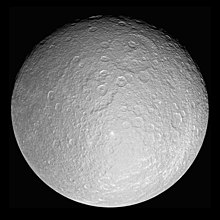Our website is made possible by displaying online advertisements to our visitors.
Please consider supporting us by disabling your ad blocker.
Rhea (moon)
 Cassini view of Rhea's anti-Saturnian hemisphere, showing the moon's two largest impact basins (Mamaldi above and left of center, and adjacent Tirawa to its upper right). At highest resolution, several long linear features are visible: halfway down from center is Harahvaiti Fossa, while near the limb left of the bottom is Koykamou Catena. | |||||||||
| Discovery | |||||||||
|---|---|---|---|---|---|---|---|---|---|
| Discovered by | G. D. Cassini | ||||||||
| Discovery date | December 23, 1672 | ||||||||
| Designations | |||||||||
| Saturn V | |||||||||
| Adjectives | Rhean | ||||||||
| Orbital characteristics [1] | |||||||||
| 527 108 km | |||||||||
| Eccentricity | 0.001 258 3 | ||||||||
| 4.518 212 d | |||||||||
| Inclination | 0.345° (to Saturn's equator) | ||||||||
| Satellite of | Saturn | ||||||||
| Physical characteristics | |||||||||
| Dimensions | 1532.4×1525.6×1524.4 km | ||||||||
Mean radius | 763.8 ± 1.0 km | ||||||||
| 7 337 000 km² | |||||||||
| Mass | (2.306 518 ± 0.000 353)×1021 kg (~3.9×10−4 Earths) | ||||||||
Mean density | 1.236 ± 0.005 g/cm³ | ||||||||
| 0.265 m/s² | |||||||||
| 0.635 km/s | |||||||||
| 4.518 212 d (synchronous) | |||||||||
| zero | |||||||||
| Albedo | 0.949 ± 0.003 (geometric) | ||||||||
| |||||||||
| 10 [2] | |||||||||

Rhea (/ˈriːə/;[a] Ancient Greek: Ῥέᾱ) is Saturn's second largest moon. It is made of ice and rock.
- ↑ Cite error: The named reference
NSESwas used but no text was provided for refs named (see the help page). - ↑ Cite error: The named reference
Observatorio ARVALwas used but no text was provided for refs named (see the help page).
<ref group=lower-alpha> tags or {{efn}} templates on this page, but the references will not show without a {{reflist|group=lower-alpha}} template or {{notelist}} template (see the help page).
Previous Page Next Page


